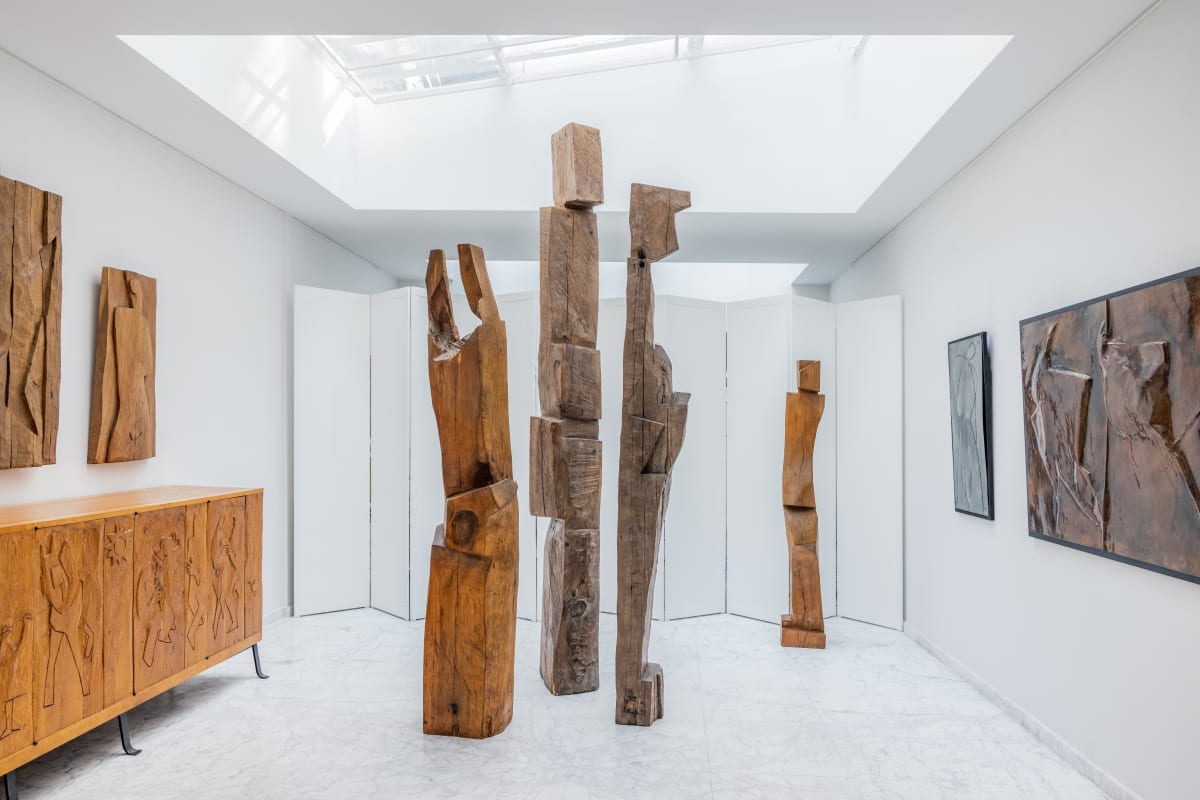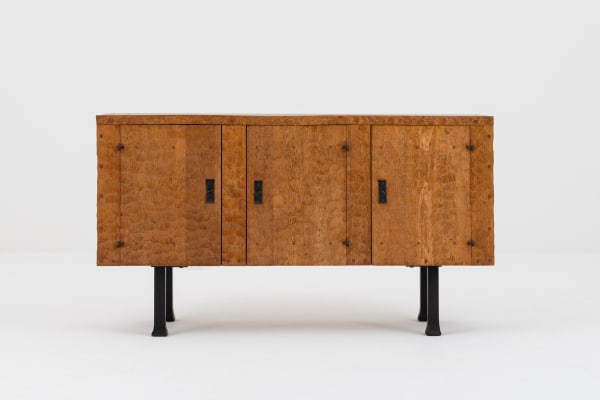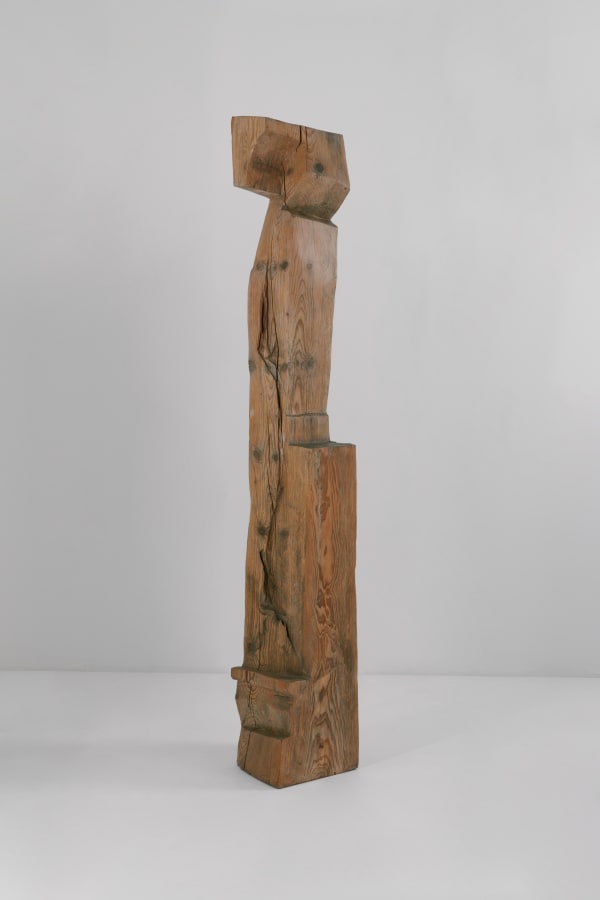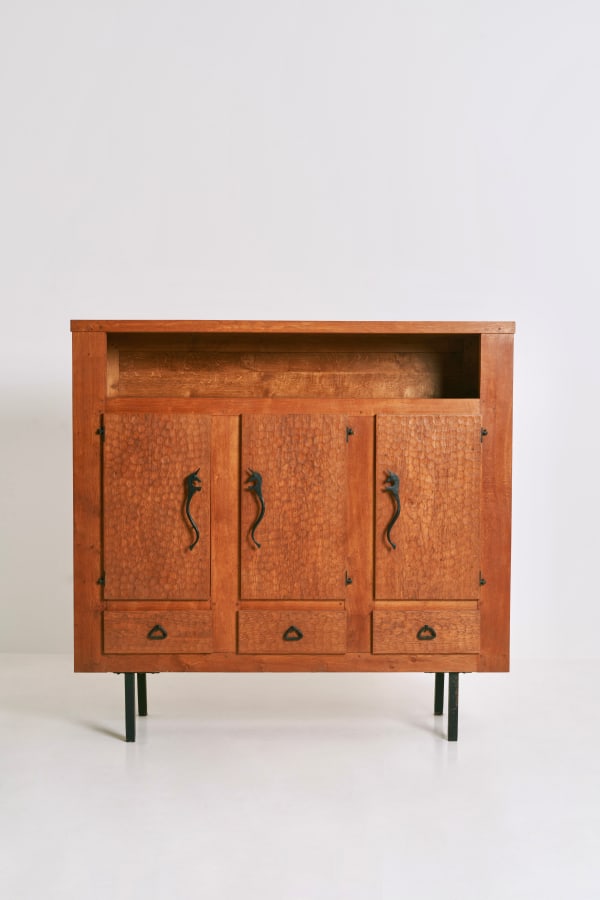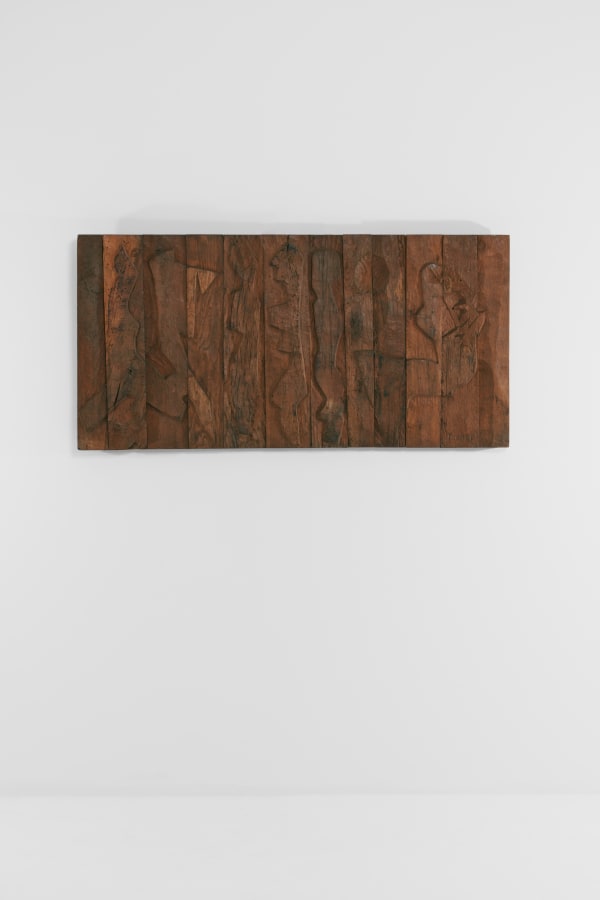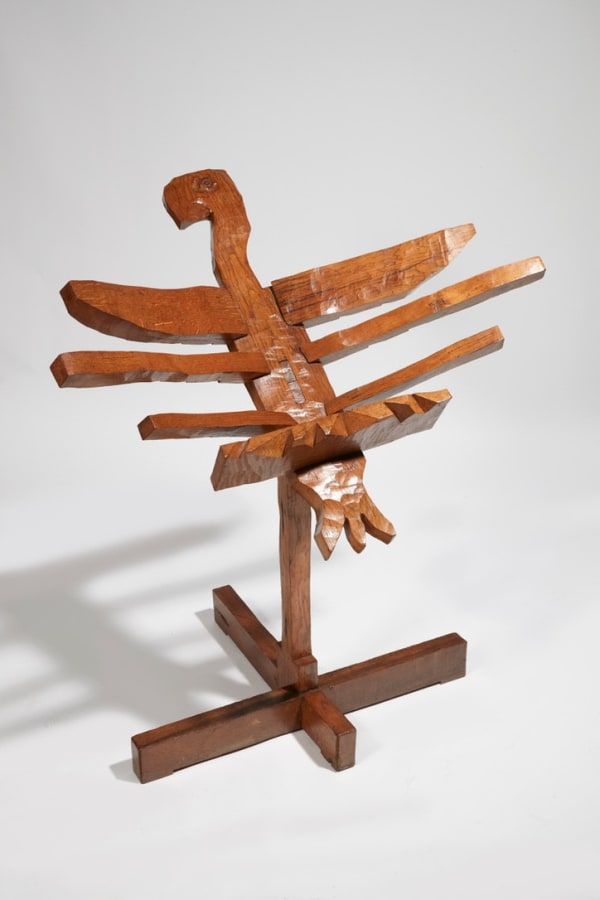Jean Touret
Unique and Humble Beginnings
Jean Touret did nothing like everyone else. He thought only about working with his hands at a time of galloping industrialisation. He had learned to paint but expressed himself through sculpture. He sculpted ceaselessly, but never sold his works. Jean Touret (1916-2004) has gone down in history notably as the creator and artistic director of the Ateliers of Marolles. This cooperative of craftsmen and artisans manufactured furniture with pure forms that is now highly sought after in the world of design. He is also known for having created the monumental high altar in bronze installed in 1981 for Notre Dame cathedral in Paris.
Growing up with modest means, Touret began his career in an insurance company in Le Mans to help his mother after the death of his father. Finding no passion in this path, he looked to enroll himself in local night classes to study drawing and painting. However, war was on the way. At 23, Touret was taken prisoner at the battle of Dunkirk and sent to Germany. Interned in the Ore Mountains, Touret was enlisted to help the old lumberjacks whose sons had gone to the front. Jean Touret, with great humanity and no vengeful hatred, admired their simplicity, their relationship with nature, and their knowledge of the forest. At their side, he learned to observe and love the trees. He managed to escape in 1945 and made it to the American lines on foot, equipped with just a map and compass.
Artistic Furniture: The Artisans of Marolles
Touret returned home determined to devote his existence to art. He settled in Marolles, a small town in the French countryside, to paint. He would help the peasants with the harvest, creating friendships in the local café and tobacco shop. This neo-rural before his time, with his glasses, his pipe and his bicycle, changed the life of the surrounding area that had become numb on the edge of modernisation. He met many local artisans, including a weaver, a blacksmith, and a carpenter, and their knowledge of ancient techniques fascinated him.
For Jean Touret, nothing was more noble than to work an ancestral material with one's hands. He initiated the Ateliers of Marolles, for whom he would draw designs for tables, lamps and buffets which were then created by the artisans in the surrounding area. They were an immediate sensation, a true phenomenon of the region. Artists and intellectuals alike flocked to Marolles. But Jean Touret’s spirit was drawn elsewhere: he began to sculpt wood, and this is his revelation.
Jean Touret, the Sculptor
Touret’s house soon overflowed with large silhouettes sculpted in tree trunks, pensive and enigmatic, as well as wall panels carved in wood and populated with figures in relief. He also worked panels in zinc and copper, embossed and incised, where dancers, musicians, and countless female forms are depicted. Of all his sculptures and wall works, Touret rarely displayed any in public, and he never sold a single one. In their message as well as their creation, they are revealed today with a profound acuteness.
In the turbulent times following the second World War, Jean Touret wanted to share his faith in beauty through his works. This mystic had discovered and marveled before the paintings of the Lascaux and Chauvet caves. Consciously or not, he used the same techniques in his works as the artists of the Magdalenian, who used the hollows and bumps of rock to give relief to the human forms and engraved animals. Touret used the volume of knotted wood and reliefs in embossed metal to give life and movement. He wanted his sculptures to be prophetic, heralding the return of joy as testimonies of eternal harmony.
A Hymn to Life Through Art
Jean Touret put his artistic passion in his sculptures just as he did in his spiritual quest. He worked with recycled materials, prevalent after the war, like wooden beams and sheets of metal. While in Marolles, he not only inspired the local artisans, but also created marionnettes for puppet shows and carnival floats, like one in the shape of a mammoth. To this day, the signs he made in metal for local merchants and weather vanes remain visible, animating the roof-tops.
Following his adventure with the artisans of Marolles, Touret moved to Les Montils, another village of the Blois area, in 1963. Just as he had brightened Marolles, Touret brought soul to these tired places. He welcomed anyone who wished to visit in his home, including gypsies, the homeless, or those suffering psychiatric troubles, for long discussions about humanity and spirituality. He would sculpt outdoors, rain or shine, and earned his meager living by creating furniture for the church.
Jean-Marie Lustiger, future Archbishop of Paris, was a great admirer of Touret's work and faith, as well as his uncommon integrity and honesty. Lustiger commissioned Jean Touret to create the high altar of the Notre Dame cathedral. The artist, always humble, never did anything halfway: his artisanal furniture brought Marolles into the history of design, and his liturgical sculptures led him to Notre Dame. His career as a sculptor remained discreet but no less intense. He is revealed with "Resurrection", the first major exhibition of Touret’s work, presented at the Galerie Yves Gastou.
-
 "Le Jugement de Paris", Circa 1970See More
"Le Jugement de Paris", Circa 1970See More -
 "Les Trois Grâces", c. 1990See More
"Les Trois Grâces", c. 1990See More -
 "Trois Guerriers", c. 1985See More
"Trois Guerriers", c. 1985See More -
 Set of 7 wall panels, c. 1980See More
Set of 7 wall panels, c. 1980See More -
 "Silhouette Féminine n° 1", c. 1970See More
"Silhouette Féminine n° 1", c. 1970See More -
 "Silhouette Féminine n° 4", c. 1970See More
"Silhouette Féminine n° 4", c. 1970See More -
 Sculpted sideboard, c. 1964See More
Sculpted sideboard, c. 1964See More -
 "Le Grand Joueur de Flûte et la Femme", c. 1960See More
"Le Grand Joueur de Flûte et la Femme", c. 1960See More -
 "Serpent" sideboard, c. 1960See More
"Serpent" sideboard, c. 1960See More -
 "Trois Visages de Flûtistes" wall panel, c. 1960See More
"Trois Visages de Flûtistes" wall panel, c. 1960See More -
 "Jean-Baptiste", 2001See More
"Jean-Baptiste", 2001See More -
 "Silhouette Féminine", 1975See More
"Silhouette Féminine", 1975See More -
 "Futuriste" Sideboard, 1958See More
"Futuriste" Sideboard, 1958See More -
 Ensemble of 8 chairs, 1958See More
Ensemble of 8 chairs, 1958See More -
 Pair of benchesSee More
Pair of benchesSee More -
 "Moïse", c. 1985See More
"Moïse", c. 1985See More -
 "Licornes" sideboard, c. 1960See More
"Licornes" sideboard, c. 1960See More -
 "Graphisme Presque Abstrait", c. 1980See More
"Graphisme Presque Abstrait", c. 1980See More -
 "La Danse", c. 1960See More
"La Danse", c. 1960See More -
 "La Fête", c. 1955See More
"La Fête", c. 1955See More -
 "Le Couple", c. 1980See More
"Le Couple", c. 1980See More -
 "Le Lutrin" Sculpture, Circa 1970See More
"Le Lutrin" Sculpture, Circa 1970See More -
 "Nu Féminin Assis de Profil", c. 1980See More
"Nu Féminin Assis de Profil", c. 1980See More -
 "Nu Féminin Debout #3", c. 1980See More
"Nu Féminin Debout #3", c. 1980See More -
 "Quatre Silhouettes Drapées" wall panel, c. 1980See More
"Quatre Silhouettes Drapées" wall panel, c. 1980See More -
 "Silhouette Féminine sur Fond Rouge" wall panel, c. 1980See More
"Silhouette Féminine sur Fond Rouge" wall panel, c. 1980See More -
 "Silhouette Haussant les Épaules", 1975See More
"Silhouette Haussant les Épaules", 1975See More -
 "Trois Silhouettes Abstraites", c. 1980See More
"Trois Silhouettes Abstraites", c. 1980See More -
 "Silhouettes animales" sideboard, 1958See More
"Silhouettes animales" sideboard, 1958See More -
 Bench, c. 1960See More
Bench, c. 1960See More -
 Bench, c. 1965See More
Bench, c. 1965See More -
 Small table, c. 1960See More
Small table, c. 1960See More -
 "Grand Prophète de Face", c. 1980See More
"Grand Prophète de Face", c. 1980See More -
 "Deux Silhouettes Hiératiques", c. 1980See More
"Deux Silhouettes Hiératiques", c. 1980See More -
 "Corps de Femme", c. 1990See More
"Corps de Femme", c. 1990See More -
 "Buste de Femme", c. 1990See More
"Buste de Femme", c. 1990See More


